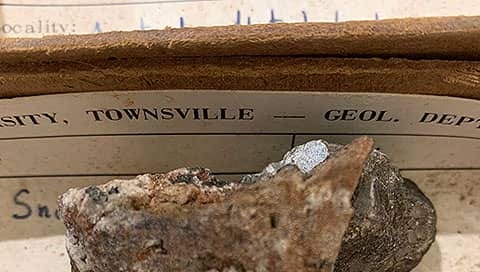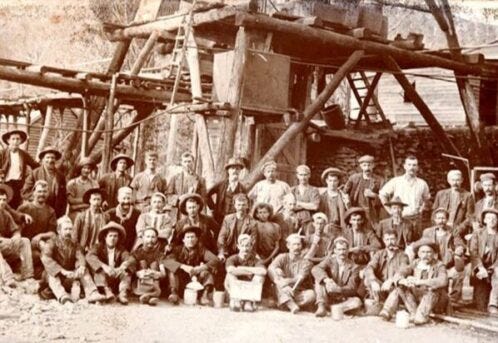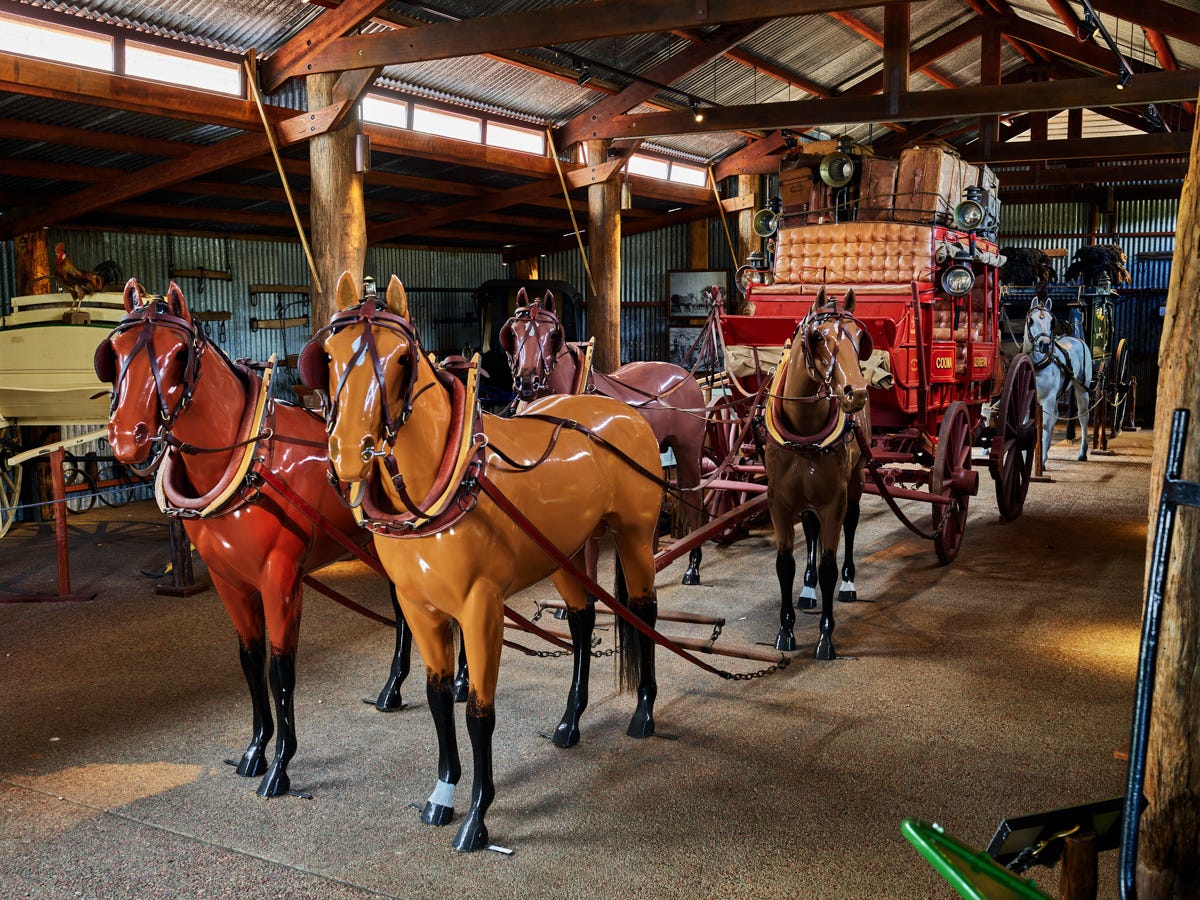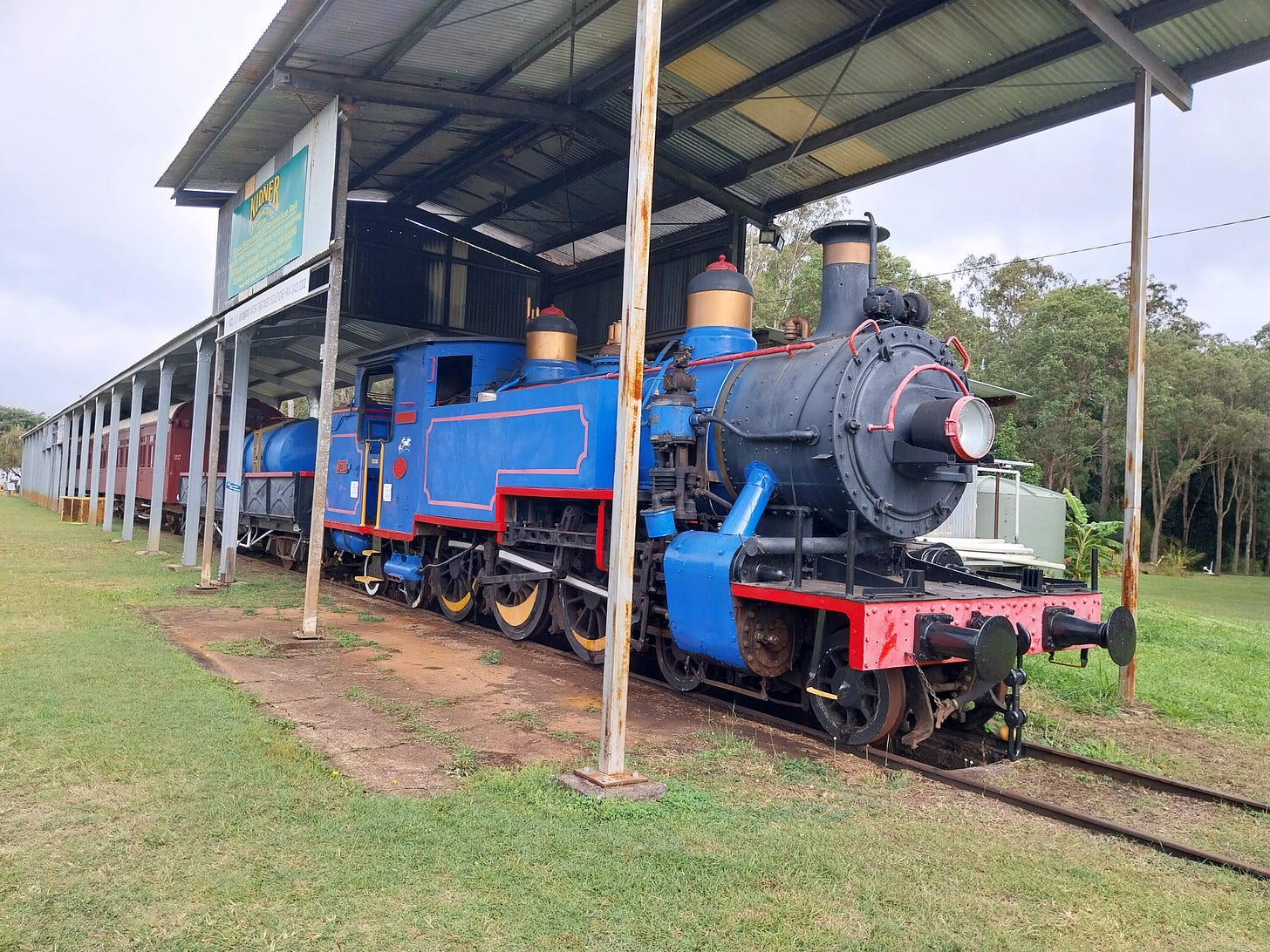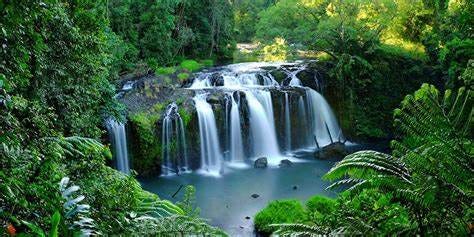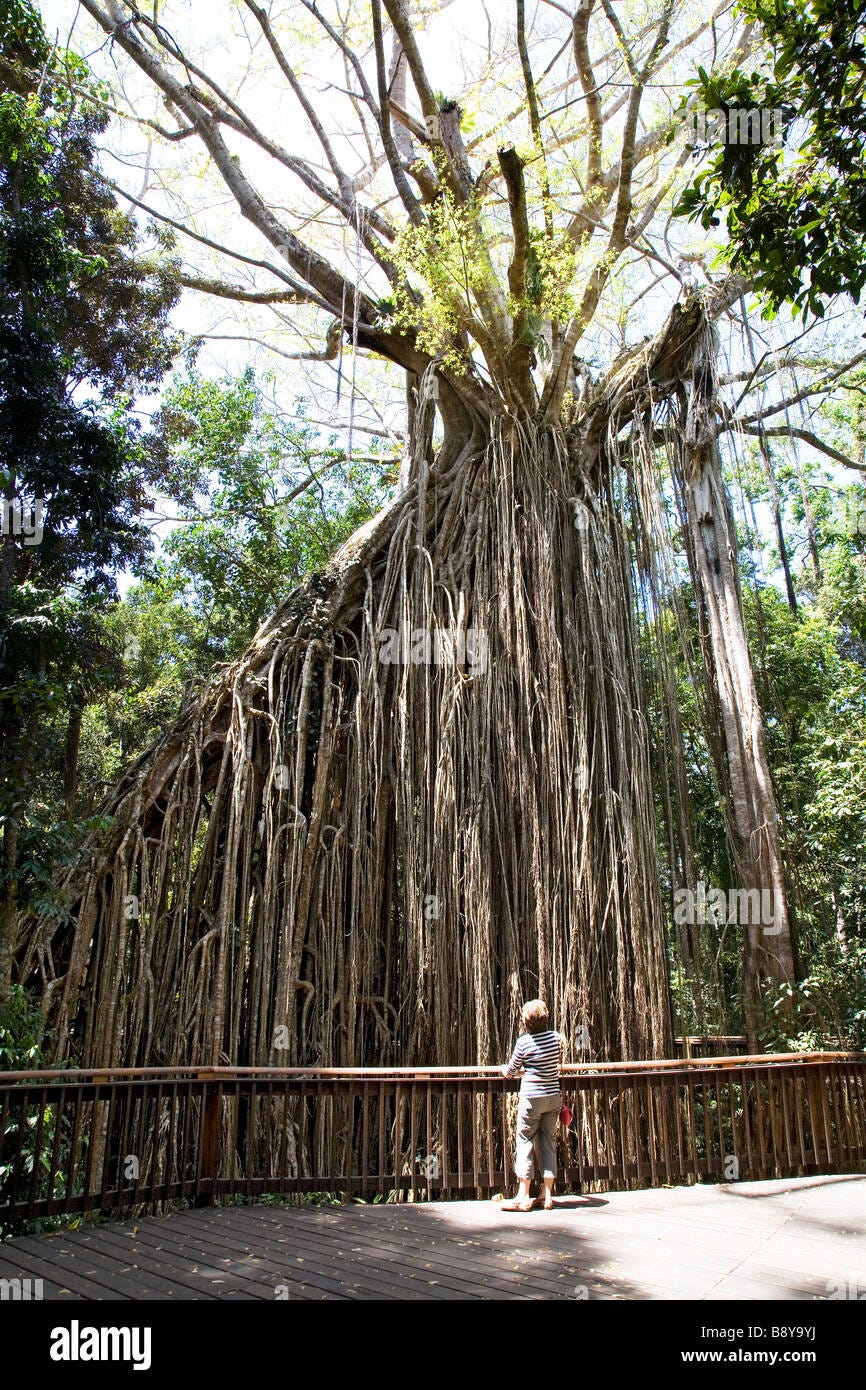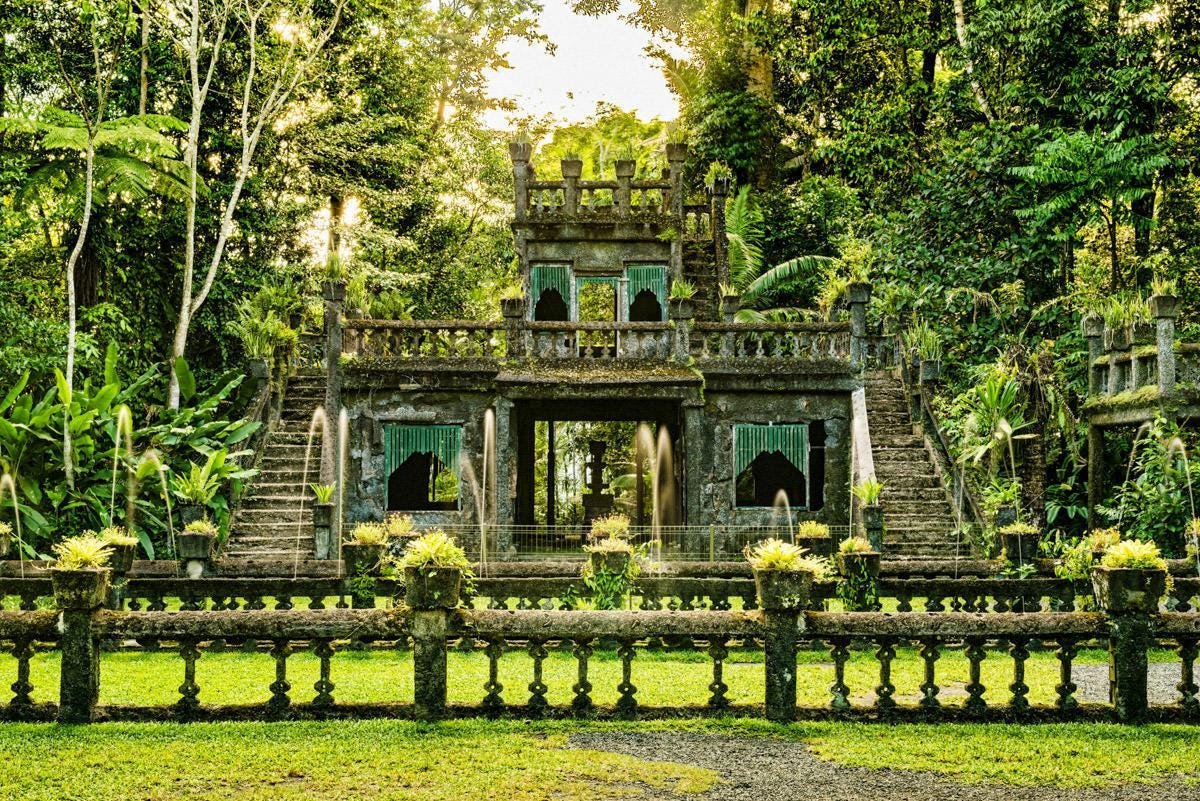Photo: Herberton Mining Museum
Become a free or paid subscriber to Michael’s Curious World to explore curious things. Interesting. surprising. Fun. Only costs a coffee a month.
CONTENTS:
A curious rock causes a mining boom
A major discovery
Herberton Historic Village
Rail engines and carriages
The Atherton Tableland
Agriculture and logging
Ravenshoe
Waterfalls
Curtain fig tree
Undara Volcanic National Park
Platypus
Paronella Park
Tolga Bat Hospital
A curious rock causes a mining boom
On June 6, 1875, a prospector named James Mulligan found a curious rock which changed the history of Australia.
Mulligan and companions were searching for gold in the remote bush area now known as Herberton, inland from tourist centre Cairns in North Queensland, when he found the rock which made him curious.
It wasn’t gold, but instead turned out to be tin ore. Mulligan became rather confused and didn’t know what to do about his tin rock. Should he claim a new discovery and try to start a mine or not bother?
He eventually decided the area was so wild and isolated that no-one would want to mine his discovery, so he moved on, returning to an established tin mine at Tinaroo.
A major discovery
Nothing happened about Mulligan’s discovery of tin until rumours began circulating in early 1880 that Chinese miners were planning to move to a new find, which revived the interest of several members of Mulligan’s party.
The Herberton Mining Museum records what happened next:
‘A group of four men from the Tinaroo Tinfield, William Jack, John Newell, Thomas Brandon and John Brown, on the assumption that the new find could be near the Wild River, returned to the area and this time found payable quantities of ore.
‘They traced the source of the ore up a small gully now locally known as Prospectors Gully (shown on some maps as the Great Northern Gully) and after initially failing to recognise the significance of the outcrops of black rocks, soon realised they were the discoverers of a major find.
‘It was, in fact, lode tin, as distinct from alluvial ore, and one of the richest finds in Australia. The following day they posted notice of the claim. The date was 20th April 1880.
‘Local folklore tells of the smelting of some samples in a tree stump to verify what it was, followed by an epic overland ride by John Newell to Thornborough to lay claim to the find.
The first mining operations actually commenced on the 8th May. By the end of that month, 100 tons of tin ore were stacked on the field. The first tin from Herberton arrived in Cairns on 17th July.’
https://herbertonminingmuseum.com/herberton/herberton-history
This discovery had big ramifications. Herberton went on to become the richest tin mining field in Australia. John Newell became Mayor of Herberton and a Member of the Queensland Parliament.
By Christmas, over 300 miners had swarmed into the town, which soon had 17 hotels. Many of the original buildings have been preserved and there is a fascinating history walk around the streets. It is easy to imagine what it was like when hundreds of miners packed the hotels and shops. It would have been a wild old place.
The town was linked to the coast when the Mulligan Highway was built in the late 19th Century and Cobb and Co coaches travelled from Herberton to what is now Port Douglas.
Herberton Historic Village
Photo: Cobb and Co. coach at Herberton Historic Village
This is a huge collection of over 60 original buildings, machinery, cars and numerous other relics from the mining, farming and timber days. It is literally amazing. We were so impressed we went back for a second day, extending our stay at the caravan park up the road.
A southern couple, Craig and Connie Kimberley, who had sold a major business and gone travelling, arrived in Herberton and were fascinated by the history of the area, so they decided to spend some money to save it by creating the historic village.
Buildings were bought, moved to the property and restored. There is a whole large shed of restored motor vehicles and a collection of John Deere tractors. Various mining machinery was rescued and repaired. The village hosts fairs, festivals and other events and has won multiple awards.
https://www.historicvillageherberton.com.au/
Herberton Mining Museum
Photot: Herberton Mining Museum
The Herberton Mining Museum located in the town is run by the Herberton Mining Museum Association and supported by the Tablelands Regional Council.
The museum is located on the site of the heritage-listed Great Northern Mine and has many indoor and outdoor exhibits, including some which are interactive, so crank those handles and push those buttons!
The site of the original discovery of payable quantities of tin ore (cassiterite, SnO₂) of April 1880 became the Great Northern Mine (also the name of a modern beer).
The 24 ha. mining freehold, selected by the original prospectors, soon passed into the hands of John Moffat who invested to expand production and founded a mining empire in North Queensland.
Three main shafts reached a depth of 200 metres. Mining continued from 1880 to 1956, producing over 5000 tonnes of ore which would today be worth about $200 million. This mine, plus the gold-mining boom at Gympie, saved Queensland from bankruptcy.
Today the surface winding plant is described as ‘the most intact in North Queensland’ and the whole of the site is heritage listed. A one-kilometres signposted walking trail leads through the mining site. The museum houses 250 sq.m. metres of historical records of the town and a research centre.
https://herbertonminingmuseum.com/museum
Rail engines and carriages
There is also a collection of restored rail engines and carriages at the railway station and tours can be arranged through the mining museum. We had a great yarn with one of the restorers who enthusiastically described the machinery.
The Atherton Tableland
Herberton is on the Atherton Tableland, a lush plateau with a population of about 26,000 which is growing, unlike many rural areas.
The coastline originally extended further eastwards, but about 100 million years ago the land fractured and the eastern section sank into the ocean. The area has an explosive history with volcanoes dating back about four million years which filled the valleys to create the current landscape, which is slowly eroding.
Lake Eacham and Lake Barrine are former volcanoes. The most recent eruption was only 10,000 years ago and further eruptions are possible.
There is a long history of indigenous occupation of the area by the Yidinji, Dyirbal and other tribes, before they were forced off their lands by Europeans.
Agriculture and logging
John Atherton and a party with cattle settled near the current town of Atherton in 1879.
Timber-cutters followed the miners into the area and farming also spread, boosted by a large Chinese population who grew fruit, vegetables and maize. Agriculture is now the largest industry and modern crops include bananas, sugarcane, corn/maize, avocadoes, strawberries, macadamia nuts.
Dairying was the largest industry until it was deregulated in 2000 and farm numbers shrank. Tourism is now the second-largest industry. Rainforest remnants, mostly in national parks, support a rich bird life and colonies of bats.
Mt Bartle Frere
The region includes the highest mountain in Queensland, Mount Bartle Frere at 1611 metres, named after an early British administrator, Sir Henry Bartle Frere. The indigenous name is ‘Choorechillum’. Covered with rainforest, it is in the Wooroonooran National Park near Babinda.
Ravenshoe
Restored train at Ravenshoe railway station.
At 930 metres, Ravenshoe is the highest town in Queensland, and also claims to have the highest railway station, hotel and bakery, while nearby Millstream Falls is the widest waterfall in Australia. It had a population of 1332 in the 2021 Census.
Want to keep reading. Become a paid subscriber to Michael’s Curious World for only a coffee a month.
We have camped several times at the Ravenshoe railway station, which features a collection of restored engines and carriages. Local musicians put on a concert on Saturday afternoons, which attracts a crowd with chairs and drinks.
Farmers settled in the area from 1881 when stands of red cedar trees were found at nearby Cedar Creek. Miner John Moffatt from Herberton purchased the farms in 1897. By 1910 Herberton was connected by rail to Cairns, Cedar Creek was renamed Ravenshoe and the rail line reached Ravenshoe in 1916. The timber industry supplied maple, oak and black walnut to Queensland.
The population continued growing, schools, churches and shops opened and closed, but the railway from Atherton to Ravenshoe closed in 1988. The locals have plans to reopen the overgrown line, which still exists, for tourists, if the funding is available.
Ravenshoe is a very pleasant place to park at the railway station, wander up town, enjoy the cooler weather compared with the steamy coast and explore the region.
Waterfalls
Gorgeous waterfalls are everywhere on the Atherton Tableland. They include:
· Tchupala Falls is part of a network of walks in the Palmerston section of Wooroonooran National Park. It can be walked separately or as part of a longer walk from Henrietta Creek to Tchupala Falls track.
· Nandroya Falls is a 6.6-kilometre circuit which begins to the west of the Henrietta Creek camping area, Palmerston
· Millaa Millaa Falls are magnificent waterfalls surrounded by lush rainforest located on the Waterfalls Circuit, along with Zillie and Ellinjaa Falls.
· Little Millstream Falls at Ravenshoe.
· Barron Gorge National Park: Rugged peaks, steep gorges, tumbling waterfalls, lush rainforest, varied wildlife, easy access, a colourful history and a range of recreational opportunities make this one of Queensland’s most popular national parks.
Lake Tinaroo was created by damming the Barron River to create an irrigation reservoir and is a popular camping spot.
Curtain fig tree
The curtain fig tree near quirky Yungaburra is a remnant of the mabi rainforest which once covered the region.
A strangler fig, this amazing 500-year-old tree is 50 metres tall with 15-metre aerial roots and is one of the largest in the region. It has been a destination on tours of the area since the 1920s and is part of the Wet Tropics World Heritage Area.
Undara Volcanic National Park
The Undara park, 275 kilometres southwest of Cairns in a 61,000-hectare national park of dry savannah woodland near Mount Surprise on the Gulf Developmental Road, protects Australia’s largest lava tube and unique flora and fauna.
It was an active volcanic area from eight million years until about 7000 years ago. The longest lava flow stretches for 160 kilometres. Holes caused by collapsing volcanic tubes make the area dangerous and access is only by guided tours. The area is rich is bird and bat life.
Platypus
Platypus-spotting is a favourite activity on the Atherton Tableland. Yungaburra has a great platypus walk and we saw several frolicking in the creek.
We also stayed at Bonadio RV and Nature Park farm stay near Atherton, where the creek is full of platypuses all day. Just pull up a seat somewhere along the one-kilometre creek walk and watch patiently. Part of the maize farm has been taken out of production and is being replanted with mabi forest.
https://www.bonadiorvandnaturepark.com/
Paronella Park
Paronella Park - Jose’s fantasy
For something a bit different, I recommend Paronella Park at Mena Creek, 120 kilometres south of Cairns.
Spanish immigrant Jose Paronella (1888-1948) built the place after arriving in Innisfail in 1913 planning to bring his fiancee Matilda out to join him. Jose successfully bought and sold sugarcane farms for 11 years and then discovered Mena Creek, a virgin rainforest.
He returned to Spain only to discover Matilda had married another man, so he proposed to her sister Margarita, who accepted, and the newly-wed couple returned to Australia in 1929 and bought five hectares at Mena Creek.
Jose had big ideas inspired by Catalan castles. He started by building a 47-step stone staircase leading to a stone cottage for the couple. Then Jose built an entertainment area, ballroom, movie theatre with ceiling mirrors reflecting blue and pink lights, planted 7000 trees, including an avenue of kauris, around the castle and even constructed a hydro-electricity station to power the facilities in 1933.
Before opening to the public in 1935 he added changing rooms for swimmers, a pavilion, refreshment rooms and a museum. He was a big thinker.
A flood devastated the area in 1946, but the family rebuilt. Jose died in 1948, but his family continued to operate the park, despite a fire in 1979 and a cyclone in 1986. The current owners bought the rundown park in 1993 and have revived it.
We camped there, had a great time exploring the complex, a swim in the pool and enjoyed the evening light show on the castle. It’s a quirky experience, but very enjoyable.
https://www.paronellapark.com.au/
Tolga Bat Hospital
This an unusual opportunity to visit a special wildlife sanctuary by appointment which rescues and rewilds more than a thousand bats every year.
The hospital has had advanced ecotourism accreditation since 2010, was voted one of the best tourism experiences in Queensland and was #1 on Tripadvisor for attractions on the Atherton Tablelands.
We found it very interesting as we are involved with Bat Rescue on the Sunshine Coast, so have a special appreciation of the hospital’s work. Many people have little personal experience of bats, which can result in some rather strange ideas about them. For example, no, they don’t eat meat – they are vegetarians.
Visits are by appointment only and can involve groups of up to 10, usually in the late afternoon. There is a charge to support the work of the hospital. Details here:
https://tolgabathospital.org/
NEXT: How to travel full-time.

